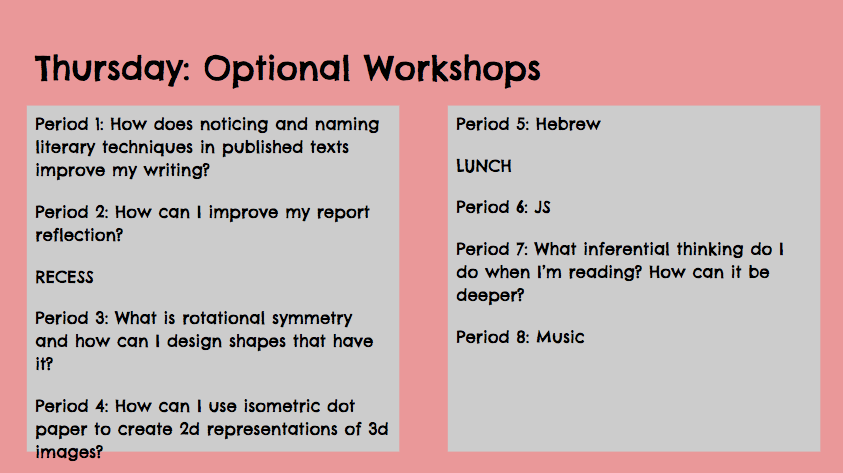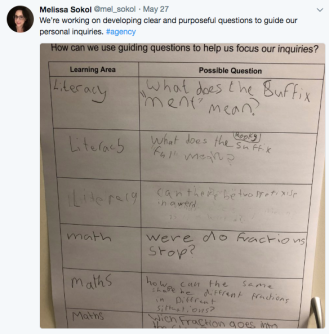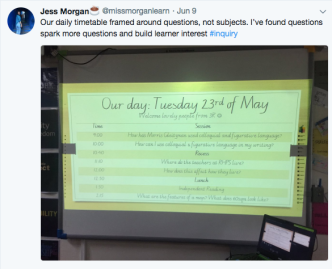So Studio Time is now ‘a thing’. It has legs. And whilst it is beginning to come together in terms of form and substance, it is also starting to flow into other areas of teaching and learning. We speak more in the collective. More than ever, I’m mindful of using ‘our’, ‘we’ and ‘us’ and it’s catching on. By bringing students into the decision-making process, a sense of ownership and personal investment in the learning community has been more palpable.
By the time we got around to another planned session of studio style learning, the students had been thinking more than I expected about how they’d spend their self-directed learning time when offered.
I’ve been thinking about workshops a lot lately. Having found this type of small group, hands-on learning to be highly engaging and effective in terms of assessing student understanding, I was keen to try it again.
So we planned another day and I offered a string of lesson-length small group workshops. This time, fewer students asked me whether I thought they needed to attend particular workshops. This time, they seemed to know. And I think this is why:
I wrote the timetable using the format of guiding questions.

Because the workshops were worded as questions, students seemed to ponder their ability to answer them. Therefore, they either knew they didn’t need to attend at all or made a choice about attending or inquiring independently.
Credit due to Jess Morgan and Melissa Sokol (via Twitter) for inspiring this idea. We’re working on students developing and sharing their own guiding questions for their inquiries.


One of the students asked me an interesting question: “You know how you said we can opt out if we want to come along but decide we don’t need to stay, we can go?”
“Ah…yep,” I replied, bracing myself for the next suggestion in the usual negotiation process.
“Well, can we opt in if at first we don’t think we need it but when you start, it sounds like something we’re interested in?”
PAUSE. THINK.
Sidebar: I’m having constant battles within myself about this sort of stuff. Why do I want to say no? Is it reasonable to say no? Is it reasonable to say yes? Are their suggestions purposeful or just curious? What benefits could potentially come from saying yes? Do I need to modify their suggestion to somehow make it work?
Also, I’ve gradually made this internal dialogue more external and transparent. I’ve actually asked myself all of the above questions out loud in front of the students – much to their amusement. Why? Because I want them to know that I have heard their ideas and if I dismiss them, it’s not because I haven’t thought about it. And also because modelling any decision-making process when the stakes are high is worth doing with kids. I need them to know that the stakes feel high to me and therefore really worth considering.
“Sure. As long as you don’t interrupt the flow of the session.”
“Cool. Thanks.”
So here’s my first surprise for the week.
The ‘opt-in’ option is powerful. It’s like my workshop is a non-intentional provocation in the middle of the classroom. The numbers seemed to quietly grow on occasion. Curiosity meant that some of them couldn’t help themselves. And even more interesting were the onlookers. Students who watched curiously from across the room. I wonder what they were thinking. Should I join? Do I need to join? Is what I’m doing more important?
I’m a little fascinated by this internal decision-making process and I might explore it with them.
The ‘opt-out’ option is also really powerful. The workshops provide enough of a provocation for wonderings, curiosities, and questioning which some students then want to pursue independently. I’ll be honest. I possibly find this too reassuring. I reflect that this makes me comfortable because I value the learning as ‘worthy’ because it is driven by the teacher. Food for thought…
But my biggest surprise of the week was how much I enjoyed the sessions. I was relaxed. Once again, my conversations with the students were productive, efficient and informative (for me as the collector of the all-powerful DATA). The room was settled. What a pleasure it is to teach to a group of students who all choose to be there. It felt collegial. And weirdly ‘grown-up’. They had these grins on their faces that seemed to express their understanding that they were doing something very adult – choosing to learn.
It’s a good message and one that ‘feels right’ but it also sounds like a case of the Emporer’s New Clothes. How much control are we putting into the students’ hands? Can they just learn what they like, and opt out of what they want to? Who decides what is age appropriate and what should be part of a school curriculum? What is considered essential knowledge and what are considered fundamental building blocks that must be learned in order to be able to understand more complex concepts? How much choice should they have over these concepts and ideas? What are the non-negotiables that will need to be taught at grade 1, 2, 3, etc? What CAN”T they opt out of?
Also, why are we assuming that students know best about their own learning? They don’t and it’s okay to say that as educators. The myth of ‘learning styles’ is still hanging around like a bad smell in a lot of schools. This had a similar fundamental flaw – students were expressing a preference of style, not the style they best learned in. Research has now debunked the idea that students can make correct decisions about HOW they best learn. Choice should be encouraged. But within limits and with caution as it can result in students attempting tasks and approaching concepts they don’t have the working memory capacity or background knowledge to deal with. Children also don’t have the maturity to select the material to be learned that will be most beneficial in the long run. They don’t know what they don’t know, and adults/teachers are supposed to be the experts who are paid to make these informed decisions. I fear this push for agency will be just as badly implemented as the learning styles.
I hope I’m wrong but I’ve seen no research published or used in the defense of agency for students or the case for teachers ‘letting go’ (care to share some?), whereas all the research (mountains of it) that suggests guided instruction with clear goals and gradual release of responsibility when students have sufficient guided practice and opportunities to build knowledge seems to be getting ignored. Students can still be actively engaged and make choices in their learning when there are clear goals and benchmarks for them to aim for. A common analogy when talking about these kinds of workshops and ‘studios’ is that the teacher is a ‘guide on the side’, acting as a roadmap to direct students, as well as other nauseating metaphors and descriptions (facilitator of learning, anyone? Or as Guy Claxton recently coined – designers of learning. When did we stop being proud of being called ‘teachers’?). Well the best guides know where they’re going and know the most efficient way of getting there. As should the best teachers.
LikeLike